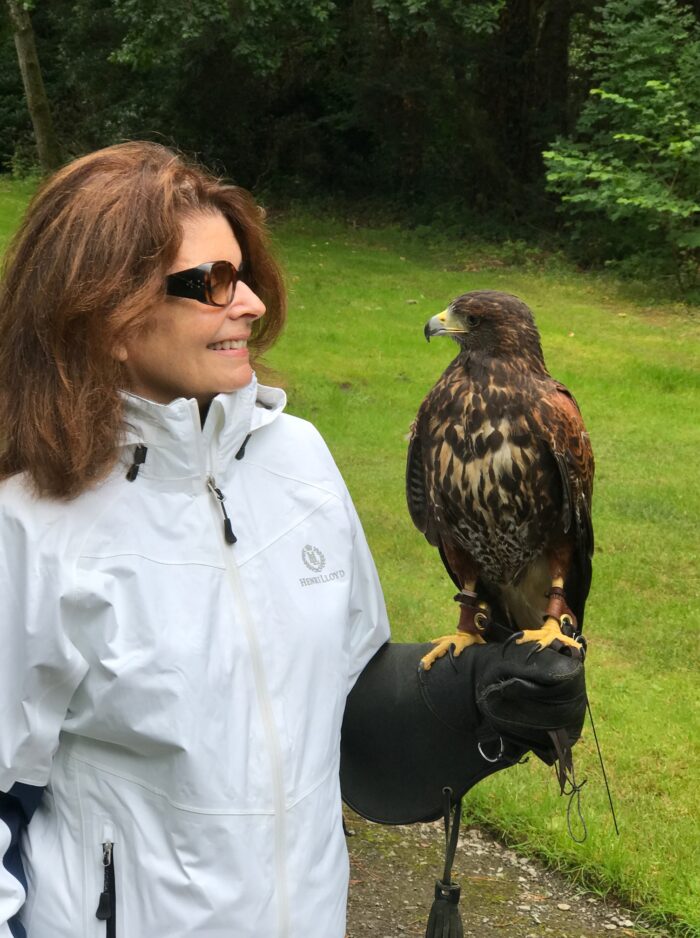The Hawk and the Dove

Teri and Ispini
This could be a Disneyesque story about the animal kingdom. The hawk and the dove get along. The hawk does not eat the dove. All is right with the world.
But no, this is a story about the aggressive and ruthless monetary policymakers who are confusing most ordinary citizens by raising interest rates enough to make stock and bond prices sink. Wiping out billions of dollars of value and calling it euphemistically “some pain.”
Before I begin, I want to tell you about a hawk named Ispini.
One afternoon Ispini and I set off tromping through the forest. She would fly off into the trees completely out of sight. When I put a little piece of raw meat in my glove, she would come out of nowhere going about 40 miles per hour and land on my glove for a quick bite. A bite of meat, not me. She would stay on my arm until I launched her.
We would repeat this process over and over until, yes, she got tired.
We also talked.
What did we talk about?
Inflation of course. I had lots of questions about her views on the inflation situation.
Her views are important because hawks have the best eyesight in the animal Queendom. Their eyesight is about eight times better than ours.
Hawks are birds of prey. Their laser like eyesight and speed, sometimes up to 150 mph, keep them at the top of the food chain.
“They catch, kill, and eat a wide variety of other animals in order to survive. This predation is not mean or cruel. It has been going on for millions of years and is, in fact, a necessary function which helps to maintain nature’s balance.”
Back to the human realm. Inflation Hawks are not birds of prey. Policymakers who are known to be “hawkish” focus on keeping inflation contained.
Recently inflation flew the coop and has soared to highs not seen in decades.
The Fed’s target inflation rate is 2%. Today inflation is above 8%.
How did that happen?
For a long time, the Fed and policymakers were Inflation Doves.
Inflation Doves are policymakers who encourage economic growth through low interest rates.
This is what happens when interest rates are too low for too long:
“When interest rates are lower, it makes it less costly for consumers to borrow to purchase goods and services. This tends to increase demand, motivating businesses to invest in hiring more workers and expanding their production facilities. Lower borrowing costs also makes it less costly for businesses to take out loans to support their expansions.
One major effect of an expanding economy is more jobs and less unemployment. However, an expanding economy also tends to lead to higher prices and wages. This can create an inflationary spiral that, especially if prices are rising faster than wages, can lead to less rather than more demand. Inflation is also hard on people living on fixed incomes.”
Dovish vs Hawkish: Key Monetary Policy Differences – (cbs19news.com)
Today the Federal Reserve is “hawkish.” They are raising interest rates to combat high inflation.
When inflation is high, higher interest rates will slow the economy and deflate the inflation bubble.
The downside is that a slowing economy is likely to create unemployment. As unemployment rises, and the economy slows the potential for a recession increases.
When the potential for a recession increases, investors start to get nervous. When investors get nervous, they start selling, everything. Stocks, bonds. There is a fast flight to cash.
In all fairness to the Fed, trying to get ahead of inflation in a pandemic is not something they have seen before, no matter how good their eyesight.
When there are enough signs (data) to see inflation coming closer to 2% they may become “dovish” by lowering interest rates.
I call it an economic policy metamorphosis. You can be an inflation hawk, and like a caterpillar becoming a butterfly, turn into an inflation dove depending on the state of the economy.
If we take a bird’s eye view of the economy what we see is the move between hawkish and dovish repeats as the economy moves through different cycles.
Whether a policy maker is hawkish or dovish is no consolation to our savings and retirement accounts.
At least we know the Fed is watching inflation like a hawk.
There is a terrific book called: “H is for Hawk” by Helen MacDonald. H is for Hawk is not about inflation.
Hawk is an autobiography of Helen’s decision to adopt and raise a goshawk. Helen was an accomplished falconer before she adopted Mabel. Goshawks are one of the most difficult hawks to train. Why did she take on the challenge? It is a captivating story.
Helen Macdonald on What Falconry Can Teach Us About Our Relationship With Raptors | Audubon
This website is for informational purposes only and does not constitute an offer to sell, a solicitation to buy, or a recommendation for any security, nor does it constitute an offer to provide investment advisory or other services by The Modest Economist LLC.
